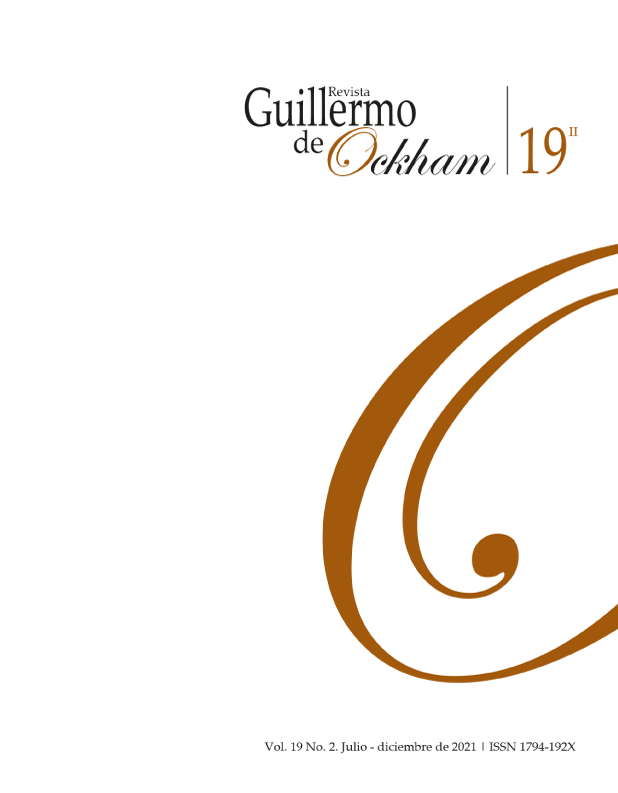The Revista Guillermo de Ockham provides an immediate and open access to its content, based on the principle of offering the public a free access to investigations to provide a global interchange of knowledge.
Unless otherwise established, the contents of this journal has a license with Creative Commons Attribution-NonCommercial-NoDerivatives 4.0 International (CC BY-NC-ND 4.0) http://creativecommons.org/licenses/by-nc-nd/4.0/
- Attribution: You must give appropriate credit, provide a link to the license, and indicate if changes were made. You may do so in any reasonable manner, but not in any way that suggests the licensor endorses you or your use.
- NonCommercial: You may not use the material for commercial purposes.
- NoDerivatives: If you remix, transform, or build upon the material, you may not distribute the modified material.
- No additional restrictions: You may not apply legal terms or technological measures that legally restrict others from doing anything the license permits.
Abstract
This article aims to examine whether the poetic depiction of Beatriz's character in The Comedy correlates with a projection of the author himself, as an idealized reverie. A critical-hermeneutical reading of Dante’s Comedy is made herein based on Gastón Bachelard’s studies on the phenomenon of poetic reverie, as well as on C. G. Jung’s on dreams and the androgynous nature of the human soul (anima-animus). The article takes two main questions into consideration: What is the psychic status of Dantean reverie? And, what is the symbolism that the female ideal of Beatriz poetically projects? It's been argued that The Comedy can be understood as a praise of the highest idealized love, while construing that the values expressed in Beatriz’s ethos and words are nothing more than a projection of the anima of Dante himself, that is to say, that in Bachelard's theory of poetic reverie, Beatriz stands as an idealization of Dante's own desire for virtue.
References
Alighieri, D. (1876). La vida nueva. Biblioteca Universal, Tomo XXI: Madrid.
Bachelard, G. (2014). La poética de la ensoñación. FCE: México.
Barthes, R. (1987). El susurro del lenguaje. Paidós: Barcelona.
Bejarano, S. (2006). El ánima como impulso vital del ensoñador de palabras. Universidad Autónoma de Occidente. En Revista Habladurías No. 5, p. 62-79. https://red.uao.edu.co/handle/10614/74
Boccaccio, G. (2016). Breve tratado en alabanza de Dante Alighieri. Edición Bilingüe.
Borges, J. (1982). Nueve ensayos dantescos en La última sonrisa de Beatriz. Ahkenaton, versión ePub.
Casas, C. (1570) Vocabulario toscano-castellano. Edición electrónica.
Collazos, E. (2013) Por la ciudad del fuego. En revista Poligramas 38, segundo semestre 2013, ISSN 0120-4130. file:///C:/Users/USUARIO/Downloads/Dialnet-PorLaCiudadDelFuego-7528507.pdf
Crespo, A. (1999). Dante y su obra. Acantilado: Barcelona.
Diccionario VOX latino-español, español-latino, Barcelona (1982).
Gilson, E. (2011). Dante y la filosofía. Eunsa: España.
Ginés, B. (2012). Beatrice Portinari como esencia de inspiración. El caso de Dante Alighieri y Dante Gabriel Rossetti. Universitat de Valencia. Saitabi. Revista de la Facultat de Geografia i Història, 62-63 (2012-2013), pp. 317-329. https://roderic.uv.es/handle/10550/39427
Guénon, R. (2005). El esoterismo de Dante. Paidós, Barcelona.
Jung, C. (1970). Arquetipos e inconsciente colectivo. Paidós: Barcelona.
Louzada, P. (2019) Dante Alighieri e a voz femenina sobredeterminada: agonismo e fantasmagoria. Lingüística y literatura ISSN 0120-5587. E-ISSN 2422-3174 N° 76, 2019, 201-218. Universidad Federal de Goiás (Brasil). DOI: https://doi.org/10.17533/udea.lyl.n76a09
Miller, K. (2009). ¿Quién es Beatriz? Las cualidades de una mujer. En Revista Realidad 120. DOI: https://doi.org/10.5377/realidad.v0i120.3398
Santayana, G. (1943). Tres poetas filósofos. Lucrecio, Dante, Goethe. Losada: Buenos Aires.
Scrimieri, R. (2001). La analogía Beatriz-Cristo. Universidad Complutense de Madrid. En Cuadernos de Filología Italiana n.° 8: 65-77. file:///C:/Users/usuario/Downloads/18411-Texto%20del%20art%C3%ADculo-18487-1-10-20110602.pdf
Scrimieri, R. (2008). Imágenes y visiones de Beatriz. Universidad Complutense de Madrid. En Revista Tenzone n° 9. http://webs.ucm.es/info/italiano/acd/tenzone/t9/scrimieri.pdf

 Perfil Google Scholar
Perfil Google Scholar































